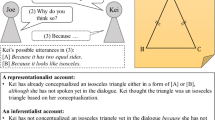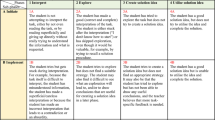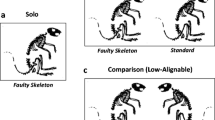Abstract
Problematic learning situations (PLS) arise when students encounter learning difficulties and their teacher encounters difficulties assisting them. The current study looks at student and teacher difficulties revealed during PLS, in the course of instruction of basic geometrical concepts for average and below-average junior high school students, when teachers apply the strategy of cognitive conflict spontaneously and inefficiently. Re-analyzing three PLS detected while observing three student teachers (Gal in Educational Studies in Mathematics, 78 (2), 183–203, 2011), I found that the teachers intuitively attempted to create a cognitive conflict but were mostly unaware of the inefficiency of this approach when students were not cognitively prepared. The findings point to the importance of enhancing teachers’ awareness of how their students think, helping them interpret their students’ understanding and encouraging them to seek the origins of student difficulties, so that teachers may be better prepared to reach a rational decision about an appropriate way to handle PLS. It is recommended to include these issues in teacher preparation and development programs.






Similar content being viewed by others
References
Balacheff, N. (1985). Experimental study of pupils’ treatment of refutations in a geometrical context. In L. Streefland (Ed.), Proceedings of the Ninth International Conference for the Psychology of Mathematics Education (Vol. 1, pp. 223–229). Utrecht, the Netherlands: State University of Utrecht: PME.
Ball, D. (2000). Bridging practices: Intertwining content and pedagogy in teaching and learning to teach. Journal of Teacher Education, 51(3), 241–247.
Battista, M. T. (2007). The development of geometric and spatial thinking. In F. K. Lester (Ed.), Second handbook of research on mathematics teaching and learning (pp. 843–908). Charlotte, NC: Information Age.
Behr, M., & Harel, G. (1990). Students’ errors, misconceptions, and cognitive conflict in application of procedures. Focus on Learning Problems in Mathematics, 12(3–4), 75–84.
Dreyfus, A., Jungwirth, E., & Eliovitch, R. (1990). Applying the “cognitive conflict” strategy for conceptual change: Some implications, difficulties and problems. Science Education, 74(5), 555–569.
Duval, R. (2006). A cognitive analysis of problems of comprehension in a learning of mathematics. Educational Studies in Mathematics, 61(1–2), 103–131.
Ericsson, K. A. (2006). Protocol analysis and expert thought: Concurrent verbalizations of thinking during experts’ performance on representative task. In K. A. Ericsson, N. Charness, P. Feltovich, & R. R. Hoffman (Eds.), Cambridge handbook of expertise and expert performance (pp. 223–242). Cambridge, UK: Cambridge University Press.
Fischbein, E. (1993). The theory of figural concepts. Educational Studies in Mathematics, 24(2), 139–162.
Fujii, T. (2003). Probing students’ understanding of variables through cognitive conflict problems: Is the concept of variable so difficult for students to understand? In N. Pateman, B. Dougherty, & J. Zilliox (Eds.), Proceedings of the 27 thInternational Conference for the Psychology of Mathematics Education (Vol. 1, pp. 49–65). Honolulu, HI: PME.
Gal, H. (1998). What do they really think? What students think about the median and bisector of an angle in the triangle, what they say and what their teachers know about it. In A. Olivier & K. Newstead (Eds.), Proceedings of the 22 ndInternational Conference for the Psychology of Mathematics Education (Vol. 2, pp. 321–328). Stellenbosch, South Africa: PME.
Gal, H. (2005). Identifying problematic learning situations in geometry instruction, and handling them within the framework of teacher training. Thesis submitted for a Doctor of Philosophy degree. Jerusalem, Israel: Hebrew University of Jerusalem (Hebrew).
Gal, H. (2011). From another perspective: Training teachers to cope with problematic learning situations in geometry. Educational Studies in Mathematics, 78(2), 183–203.
Gal, H., Lin, F. L., & Ying, J. M. (2009). Listen to the silence: The left-behind phenomenon as seen through classroom videos and teachers’ reflections. International Journal of Science and Mathematics Education, 7(2), 405–429.
Gal, H., & Linchevski, L. (2000). When a learning situation becomes a problematic learning situation: The case of diagonals in the quadrangle. In T. Nakahara & M. Koyama (Eds.), Proceedings of the 24 thInternational Conference for the Psychology of Mathematics Education (Vol. 2, pp. 297–304). Hiroshima, Japan: PME.
Gal, H., & Linchevski, L. (2010). To see or not to see: Analyzing difficulties in geometry from the perspective of visual perception. Educational Studies in Mathematics, 74(2), 163–183.
Ginsburg, H., & Opper, S. (1969). Piaget’s theory of intellectual development. An introduction. Englewood Cliffs, NJ: Prentice-Hall.
Gómez-Chacón, I. M. (2000). Affective influences in the knowledge of mathematics. Educational Studies in Mathematics, 43(2), 149–168.
Harel, G. (2008). DNR perspective on mathematics curriculum and instruction. Part 1, focus on proving. Zentralblatt fuer Didaktik der Mathematik, 40(3), 487–500.
Harel, G., & Sowder, L. (1998). Students’ proof schemes: Results from exploratory studies. In A. H. Schoenfeld, J. Kaput, & E. Dubinsky (Eds.), Research in collegiate mathematics education (Vol. III, pp. 234–283). Providence, RI: American Mathematical Society.
Henderson, D. W. (2001). Experiencing geometry: In Euclidean, spherical and hyperbolic spaces (2nd ed.). Upper Saddle River, NJ: Prentice-Hall.
Houdement, C., & Kuzniak, A. (2003). Elementary geometry split into different geometrical paradigms. In M. Mariotti (Ed.), Proceedings of of the 3rd Congress of the European Society for Research in Mathematics Education (Vol. 3, pp. 1–10). Bellaria, Italy: European Research in Mathematics Education.
Hsieh, H. F., & Shannon, S. E. (2005). Three approaches to qualitative content analysis. Qualitative Health Research, 15(9), 1277–1288.
Jacobs, V. R., Lamb, L. L., & Philipp, R. A. (2010). Professional noticing of children’s mathematical thinking. Journal for Research in Mathematics Education, 41(2), 169–202.
Kang, S., Scharmann, L., & Noh, T. (2004). Reexamining the role of cognitive conflict in science concept learning. Research in Science Education, 34, 71–96.
Koedinger, K. (1998). Conjecturing and argumentation in high-school geometry students. In R. Lehrer & D. Chazan (Eds.), Designing learning environments for developing understanding of geometry and space (pp. 319–347). Mahwah, NJ: Lawrence Erlbaum.
Kuzniak, A., & Rauscher, J.-C. (2011). How do teachers’ approaches to geometric work relate to geometry students’ learning difficulties? Educational Studies in Mathematics, 77(1), 129–147.
Laursen, P. F. (2007). Student teachers’ conceptions of theory and practice in teacher education. Paper presented at the biannual ISATT conference, Brock University, Canada.
Leatham, K. R., Peterson, B. E., Stockero, S. L., & Van Zoest, L. R. (2015). Conceptualizing mathematically significant pedagogical opportunities to build on student thinking. Journal for Research in Mathematics Education, 46(1), 88–124.
Lee, G., & Yi, J. (2013). Where cognitive conflict arises from? The structure of creating cognitive conflict. International Journal of Science and Mathematics Education, 11(3), 601–623.
Limon, M. (2001). On the cognitive conflict as an instructional strategy for conceptual change: A critical appraisal. Learning and Instruction, 11, 357–380.
Mitchelmore, M., & White, P. (2000). Development of angle concepts by progressive abstraction and generalization. Educational Studies in Mathematics, 41(3), 209–238.
Noss, R. (1987). Children’s learning of geometrical concepts through logo. Journal for Research in Mathematics Education, 18(5), 343–362.
Parzysz, B. (1988). “Knowing” vs “seeing”: Problems of the plane representation of space geometry figures. Educational Studies in Mathematics, 19(1), 79–92.
Skemp, R. R. (1979). Intelligence, learning and action. London, UK: Wiley.
Star, J. R., & Strickland, S. K. (2008). Learning to observe: Using video to improve preservice mathematics teachers’ ability to notice. Journal of Mathematics Teacher Education, 11(2), 107–125.
Tall, D. O. (1991). The psychology of advanced mathematical thinking. In D. O. Tall (Ed.), Advanced mathematical thinking (pp. 3–21). Dordrecht, the Netherlands: Kluwer Academic.
Tall, D. O., & Vinner, S. (1981). Concept image and concept definition in mathematics with particular reference to limits and continuity. Educational Studies in Mathematics, 12(2), 151–169.
Tirosh, D., Stavy, R., & Cohen, S. (1998). Cognitive conflict and intuitive rules. International Journal of Science Education, 20(10), 1257–1269.
Van Hiele, P. M. (1986). Structure and insight. A theory of mathematics education. New York, NY: Academic Press.
Vinner, S. (1997). The pseudo-conceptual and pseudo-analytical thought processes in mathematics learning. Educaccs, 34, 97–129.
Wadsworth, B. J. (1984). Piaget’s theory of cognitive and affective development (3rd ed.). New York, NY: Longman.
Wertheimer, M. (1958). Principles of perceptual organization. In D. Beardslee & M. Wertheimer (Eds.), Readings in perception (pp. 115–135). Princeton, NJ: Nostrand.
Zazkis, R., & Chernoff, E. (2008). What makes a counterexample exemplary? Educational Studies in Mathematics, 68, 195–208.
Zhang, D., Wang, Q., Ding, Y., & Liu, J. J. (2014). Testing accommodation or modification? The effects of integrated object representation on enhancing geometry performance in children with and without geometry difficulties. Journal of Learning Disabilities, 47(6), 569–583.
Author information
Authors and Affiliations
Corresponding author
Additional information
Publisher’s note
Springer Nature remains neutral with regard to jurisdictional claims in published maps and institutional affiliations.
Appendix: extended analysis of PLS 3
Appendix: extended analysis of PLS 3
PLS often require multidimensional analysis of both student and teacher difficulties, using more than one theory or research approach simultaneously (for more examples of multidimensional analysis, see Gal & Linchevski, 2010; Gal, 2011). The following suggests additional perspectives for analyzing PLS 3.
1.1 Logical analysis
A logical analysis of the PLS suggests two difficulties. The first is a two-way implication fallacy. The student learned that if triangles are congruent, then angles are correspondingly equal; due to the fallacy, she now claims that if angles are correspondingly equal, then triangles are congruent. The teacher fails to convince her that this is not always true.
The second possible difficulty is the implication of the negation fallacy, whereby the student interprets “does not necessarily imply” congruence, as suggested by the teacher’s counter-example, to mean “negatively implies” lack of congruence. According to Harel, “Many propositions in mathematics seem trivial to students because they judge them in terms of epistemic values rather than logical values” (2008, p. 497). Moreover, it is accepted that difficulties in logical thinking make it difficult to experience cognitive conflict (Kang et al., 2004). There also seem to be differences between the teacher’s (expert) proof scheme, which is probably deductive, and the one clearly attempted by the student, based on external conviction, i.e., where proving depends on an authority such as the teacher (Harel & Sowder, 1998).
1.2 Mismatch between level of instruction and student’s level of geometrical thinking
Van Hiele (1986) considers the cognitive skills of proving to be levels 3 and 4. Students at level 3 perceive relationships between properties and figures, can create meaningful definitions, and can provide informal arguments to justify their reasoning. Those at level 4 can construct proofs, understand the role of axioms and definitions, and know the meaning of necessary and sufficient conditions. In our case, however, the student only understood that this activity required using a side, an angle, and another side. Because you can see in the figure that these parts are (correspondingly) equal, she could point them out, even though they were not given as data. Her reactions point to van Hiele’s first or second level of thinking. A student at level 1 recognizes figures by their global appearance, often by comparing them to a known prototype. The properties of a figure are not perceived until level 2. The student’s reactions (e.g., “But I do see it. I’m not blind.”) are all explanations based on viewing the figures either by their global appearance or by partial analysis of their properties. The dialogue indicates that proofs and postulates are not a meaningful justification for the student and that the teacher’s attempt to apply these modalities (e.g., “There is no ‘to see’ in geometry.”) results in pseudo-conceptual and pseudo-analytical behavior. The student’s way of handling the assignment (folding the triangles to show they are congruent) suggests she is involved in Natural Geometry (Geometry I) and not Formalist Geometry (Geometry III) or even Natural Axiomatic Geometry (Geometry II) (Kuzniak & Rauscher, 2011). The passage from Geometry I to II “is the first time in mathematics that the mental perspective on the object has to change drastically, without any ‘visual’ change, symbol or pictorial aid” (Houdement & Kuzniak, 2003, p. 6).
1.3 Difficulties in visual perception
Gestalt principles guide the organization of shapes and objects which were extracted from the visual scene into groups to form the object (Wertheimer, 1958). The factor of proximity suggests that grouping occurs on the basis of small distance (Wertheimer, 1958; see Fig. 7).
This makes it difficult to decompose the configuration of two triangles sharing a common side. When the teacher directed the student’s attention, she was able to find the common side.
Rights and permissions
About this article
Cite this article
Gal, H. When the use of cognitive conflict is ineffective—problematic learning situations in geometry. Educ Stud Math 102, 239–256 (2019). https://doi.org/10.1007/s10649-019-09904-8
Published:
Issue Date:
DOI: https://doi.org/10.1007/s10649-019-09904-8





